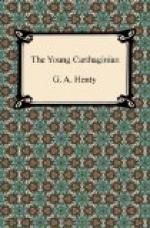Divided in brigades, each working six hours, the troops laboured night and day, and in three days from its commencement the gallery was carried under the walls. It was then driven right and left for thirty yards each way, and was filled with wood, combustibles, and explosives. The workers then retired and the wood was fired, the props supporting the roof were soon burned away, the earth above fell in bringing down the walls, and a great breach was made, through which the besiegers, drawn up in readiness, rushed in and captured the town.
On the same day that Hannibal captured Turin, Scipio entered Piacenza. After finding that Hannibal had escaped him on the Rhone, he had despatched the principal part of his army, under his brother Cneius, to Spain, their original destination, and with the rest sailed to Pisa and landed there. Marching with all haste north he enlisted 10,000 troops from among the inhabitants of the country, many of them having already served in the Roman army. He then marched north to Tenneto, where he was joined by the praetors Manlius and Attilius with over 20,000 men, with whom he marched to Piacenza.
Hannibal, after, as usual, rousing the enthusiasm of his soldiers by an address, marched towards Scipio. The latter, with his cavalry, had crossed the Ticino and was within five miles of Vercella, when Hannibal, also with his cavalry, came within sight. Scipio’s front was covered with a swarm of foot skirmishers mixed with irregular Gaulish horsemen; the Roman cavalry and the cavalry of the Italian allies formed his main body.
Hannibal ordered the Carthaginian horse to charge full upon the centre of the enemy, and the Numidians to attack them on both flanks. The Romans, in those days, little understood the use of cavalry, the troops frequently dismounting and fighting on foot. Hannibal’s soldiers were, on the other hand, trained to fight in tactics resembling those of modern days. No sooner was the word given to charge than the Carthaginian horse, delighted at being at last, after all their toils and sufferings, within striking distance of their foes, gave a mighty shout, and setting spurs to their splendid horses flung themselves at the enemy.
The charge of this solid mass of picked cavalry was irresistible. They swept before them the skirmishers and Gaulish horse, and fell with fury upon the main body, cleaving a way far into its ranks. Before the Romans could recover from their confusion the Numidian horse burst down upon their flanks. The charge was irresistible; large numbers of the Romans were killed and the rest fled in panic, hotly pursued by the Carthaginians, until they reached the shelter of the Roman infantry, which was advancing behind them. Scipio, who had been wounded in the fight, at once led his army back to Piacenza.
The news of this battle reached Malchus just as he was preparing to depart. The messenger who brought it brought also a lead horse, which Hamilcar had sent for his son’s use. Resuming his armour Malchus mounted and rode off at once, after many warm thanks to his friends, whom he expected to see again shortly, as they, with the rest of that section of the tribe, were about to join the chief — the Gaulish women frequently accompanying their husbands in their campaigns.




